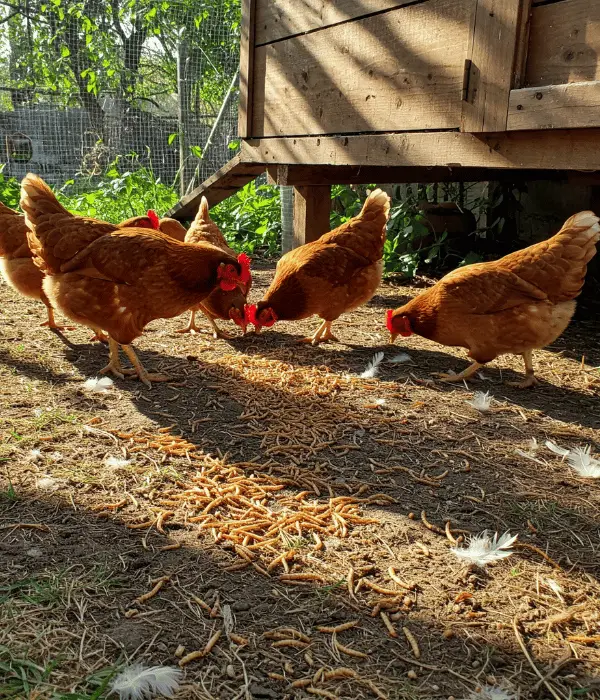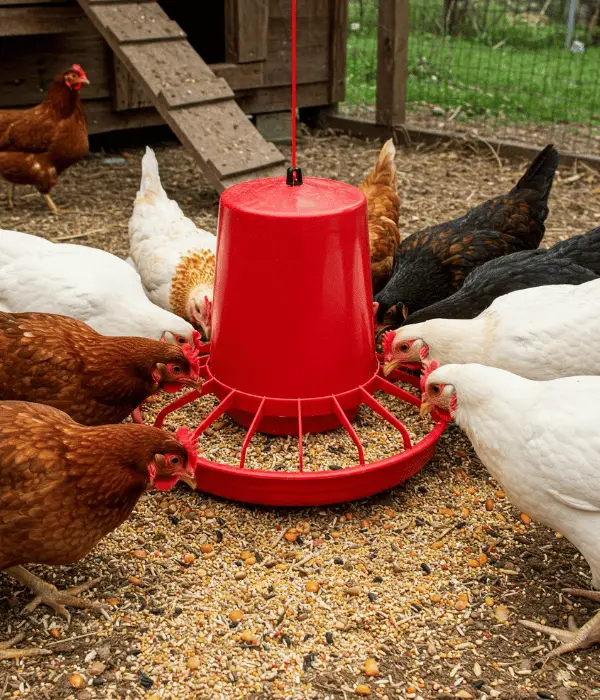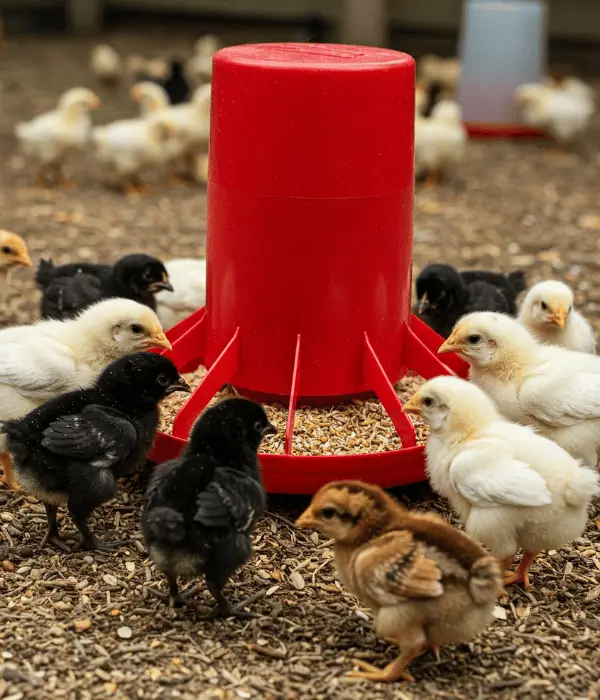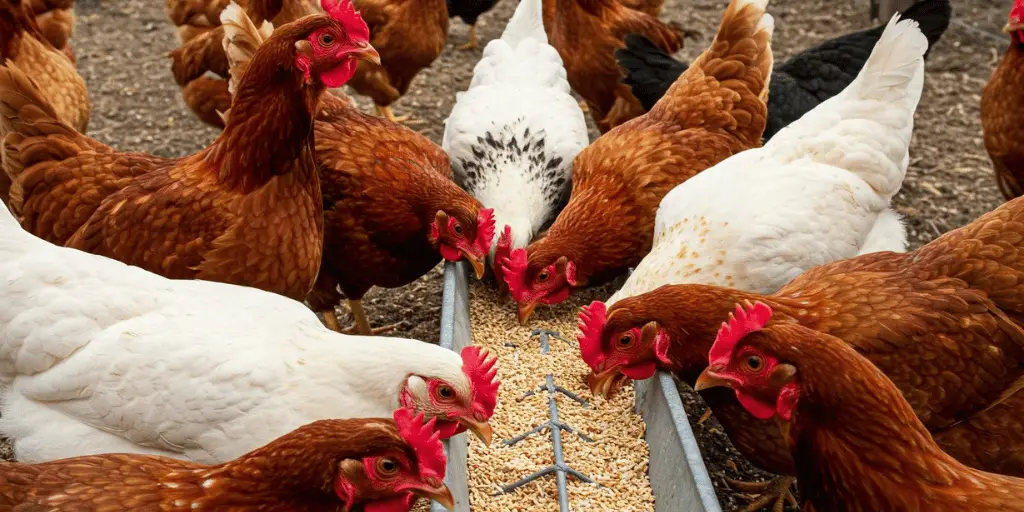What is the significance of protein in chicken feed, and how does it contribute to poultry health?
Protein in chicken feed is not simply another nutrient; it is the foundation of chicken growth, egg production, and overall bird health.
Whether you are a beginner or a professional in pasture land, defining protein in chicken feed needs in poultry nutrition is an indispensable prerequisite for raising robust, productive birds.
We will provide a comprehensive overview of protein levels, amino acid requirements, and various factors affecting chicken health, and, consequently, the health of your pasture.
The Role of Protein in Chicken Feed
Poultry proteins are essential elements for transforming poultry growth processes.
They participate in every aspect of living organisms, including muscle formation and immune system function, and are essential for maintaining the health of healthy chickens.

Muscle Development and Growth
Proteins are necessary for producing and maintaining muscle tissue in chickens.
The protein in the chicken’s rich feed is broken down into amino acids by the digestive system when digested in the gut.
The amino acid then reassembles into new proteins for muscle growth, and these new proteins regulate the volume of meat yield and the chicken’s overall health.
Immune System Support
A balanced protein diet in chicken feed strengthens the immune system. Proteins make antibodies, which eliminate diseases and infections.
This natural defense is particularly significant in commercial poultry farms, where disease prevention is a major factor in flock survival.
Feather Formation
Long and healthy feathers are only achievable with sufficient protein in the chicken feed intake.
Keratin is the major component of feathers, a protein that provides support and protection to the body.
Proper feathering needs high-protein chicken feed, especially during molting.
Egg Production
Proteins play a crucial role in egg production in laying hens. Around 90% of egg white is protein, and hens need a consistent supply of it in their feed for continuous egg production. Inadequate protein can lead to underproduction of eggs.
Enzyme and Hormone Production
All life processes depend on proteins, which act as enzymes to promote digestion and hormones to regulate various bodily functions.
Such biological compounds are involved in the metabolism and growth regulation of poultry, which manifests in optimal development at various life stages.
Essential Amino Acids in Poultry Feed
Amino acids are essential nutrients that are the building blocks of proteins. They are essential for the chicken’s growth, development, and health.
Hence, we need to understand these nutrients to formulate well-balanced feed for the birds.
Key Essential Amino Acids for Poultry
Poultry require certain essential amino acids that they cannot manufacture. The most crucial ones include:
- Lysine: Promotes muscle growth and aids in protein synthesis.
- Methionine: Vital for feather growth and egg production.
- Threonine: Important for digestion and immunity.
- Tryptophan: This item helps alleviate stress-related coping and behavioral issues.
- Valine: Promotes the maintenance and repair of muscle tissue.
These amino acids must be provided through protein feeds for chickens since birds cannot synthesize them internally.
A deficiency in these can lead to reduced growth rates, poor feed conversion, and decreased egg production.
Balancing Amino Acid Ratios
Maintaining proper amino acid ratios is just as important as meeting individual requirements.
The ideal protein concept suggests that all essential amino acids should be present in specific proportions relative to lysine, which is often used as the reference amino acid.
For optimal performance, consider these ratios:
- Methionine should be at least 40% of lysine levels.
- Threonine should maintain a 65% ratio to lysine.
- Tryptophan should be around 17% of the lysine content.
Feed ingredients should be carefully selected and combined to achieve these ratios.
Common protein sources in chicken feed, such as soybean meal, corn, and synthetic amino acids, can help meet these requirements in a cost-effective manner.
Keep in mind that different production stages require varying levels of amino acids. Growing chicks need higher protein levels for rapid tissue development.
Laying hens require specific ratios for sustained egg production, which affects the protein content in chicken feed.
Protein Sources in Chicken Feed

Natural Protein Sources
The sources of protein in chicken feed are rich in nature, and are various and worthwhile.
Among the most common and effective proteins are soybeans, which have a crude protein level of 44%.
Plant-based protein sources are essential for poultry nutrition because they contain amino acids that chickens cannot synthesize themselves.
These amino acids are vital components of feathers, which play a critical role in the biological makeup of birds.
Fish meal, derived from processed fish, can be considered another excellent natural protein source in chicken feed.
It contains an average of 60% to 70% protein and is highly digestible for chickens, as it is rich in essential amino acids.
In addition, fish meal will also provide some fantastic omega-3 fatty acids that can gradually improve bird health.
Treats like insects and worms are high-protein options that chickens will gather in the wild.
You can feed chickens mealworms, which offer 50% protein, and which can be easily cultivated or bought as a regular feed supplement.
Commercial Protein Sources
The production of modern poultry feed has grown. The poultry feed industry has phased out synthetic protein feeds, replacing them with nutritionally comparable feeds that have verifiable nutrient bioavailability.
Soybean meal, the most widely used commercial protein source for chicken feed, is produced by removing anti-nutritional factors while retaining the high protein content of soybeans.
Commercial feed manufacturers usually use synthetic amino acids to achieve a balanced protein profile in their products.
This strategy fulfills the specific bio-nutritional demands while minimizing the total crude protein in the feed.
Blood meal is a by-product of the meat processing industry used in commercial feeds and a concentrated protein source in chicken feed.
With protein levels reaching up to 80%, it boasts an excellent amino acid profile that supports muscle development and egg production.
Many commercial feeds also include meat and bone meal as protein sources in chicken feed. These ingredients provide protein and essential minerals, such as calcium and phosphorus, necessary for the development of chickens’ muscles and skeletal strength.
Optimal Protein in Chicken Feed Levels for Different Production Stages

Protein Requirements During Growth Stages
Protein in chicken feed requirements vary significantly in a chicken’s life cycle.
In the early growth stages (0-8 weeks), chicks require higher protein levels to support the rapid muscle development and feather growth.
Starter feeds containing 20-22% protein are optimal for chick development, which affects the protein content in chick feed.
As the birds move into the grower phase (8-16 weeks), their protein needs gradually fall.
Grower feeds typically contain 16-18% protein, which helps sustain the birds’ growth while preventing them from gaining excessive fat.
This ensures healthy development without wasting expensive protein resources.
Managing Protein in Chicken Feed for Laying Hens
It is crucial to provide specific protein levels to laying hens for their proper egg production and body condition.
Laying pullets require protein in their chicken layer feed at levels of around 17-19% during the pre-laying period (16-20 weeks) to be ready to start egg production.
During the egg production period, hens should have a diet containing 16-18% protein, which can cause consistent egg production.
Thus, the following processes can be optimized:
- Regular egg-laying cycles
- A strong eggshell formation
- A good body weight
- A healthy feather condition.
Broiler breeders have differing opinions on the inclusion of protein in chicken feed.
To prevent breeders’ obesity while they are still producing eggs, they require a carefully controlled protein level of 15-17% beforehand.
However, to avoid fertility issues and low reproductive capacity, excess protein is also avoided.
Impact of Protein Quality on Bird Health
Protein quality is central to the policy of health and performance for your birds.
In poultry nutrition, different proteins are neither all equal nor equally beneficial for birds, and understanding the differences in protein is a key factor in the flock’s health and well-being.
Digestibility and Absorption
In a bird’s digestive tract, high-quality proteins break down and are absorbed more easily.
Better protein digestibility means more amino acids are available for essential body functions.
The body excretes poor-quality proteins without effectively utilizing them, resulting in waste and gastrointestinal issues.
Immune System Support
It is necessary to have sufficient quality protein in the chicken feed to support the immune system’s reinforcement.
Providing birds with enough protein helps them fight off illnesses and promotes their well-being.
The amino acids derived from high-quality proteins are essential for producing antibodies and other components of the immune system.
Growth and Development
Birds fed superior protein in chicken feed sources achieve better growth rates and muscle development.
Proper tissue formation relies on quality proteins and their repair, resulting in stronger birds with improved muscle tissue.
This is especially critical in the early stages of growth when rapid development occurs.
Feathering and Appearance
Protein quality has a direct impact on the feathering process and the overall appearance of birds.
Birds that typically display their best plumage consume high-quality protein in chicken feed, which helps maintain their body temperature and protects them from external dangers.
In fact, these two points are important features. The birds that eat feed with inferior proteins often experience the delayed process of feathering and ugly feathers.
Metabolic Efficiency
Upgrading metabolic efficiency by improving the quality of protein in chicken feed.
To achieve this, the birds consume high-quality proteins, which conserve energy during feeding and enable more resources to be allocated to growth and production.
The result is that feed conversion is being improved, and birds continue to be healthy.
FAQs
Can chickens produce eggs without adequate protein in chicken feed?
No, chickens require a sufficient amount of protein for egg production. Without adequate protein, egg laying will decrease or stop altogether. Protein provides the body with all the amino acids that make up egg whites. A layer hen will need about 16-18% of proteins in their feed for the best egg production, directly affecting how much protein is in chicken layer feed.
How do seasonal changes affect protein requirements in the protein in chicken feed?
As the temperature drops, the chickens require more energy to stay warm, so they need a slight increase in protein intake. Summer means the protein requirement remains stable, but food usage might decrease. Therefore, it is also imperative to sustain stable protein levels and adjust the total feed amount according to seasonal practices.
What happens if chickens consume too much protein in chicken feed?
Too much protein is harmful to poultry. It can cause problems such as kidney stress, which leads to increased water consumption and a significant amount of waste nitrogen being disposed of along with the feed. The hen also uses more energy to convert the surplus of amino acids into energy, which is a poor way of utilizing feed resources.
Is there a difference in protein requirements between heritage and commercial chicken breeds?
Yes, heritage breeds typically need less protein than commercial strains. Commercial broilers require 20-22% protein for optimal growth, while heritage birds thrive on 16-18%. This is because those birds grow more slowly, and their genetic background differs from that of the commercial broilers.
How can I naturally supplement protein in chicken feed during periods of feed shortage?
You can increase your chickens’ protein intake by providing them with black soldier fly larvae, mealworms, or making fodder available to them. Free-ranging is also a good option because chickens can catch and eat worms and insects. You may also grow legumes, such as clover or alfalfa, in their forage area, which serves as an additional protein source in chicken feed.
What role does protein play in feather development during molting, and does that change the required protein content in chicken feed?
During the molting process, feather production heavily relies on the availability of protein, primarily the keratin from which feathers are formed. When chickens molt, they require extra protein levels (about 20%) to help them grow new feathers and stay healthy. Feather production may slow down if chicken feed lacks protein. Low protein intake can lead to poor-quality feathers, underscoring the importance of high-protein feed during the molting period.
How do you calculate protein percentage in chicken feed?
To calculate the protein percentage, you need to know the amount of crude protein present in the feed and the total weight of the feed. Divide the weight of crude protein by the total weight of the feed, then multiply by 100 to obtain the percentage. For example, if a 100-pound feed bag contains 20 pounds of crude protein, the protein percentage is (20/100) * 100 = 20%.
What is crude protein in chicken feed?
Crude protein in chicken feed refers to the total amount of protein in the feed, measured by the nitrogen content. It’s a standard measure used to estimate the protein value of feed, but it doesn’t show the digestibility or quality of the protein.
What chicken feed is high in protein?
Feeds with soybean meal, fish meal, or meat and bone meal are typically high in protein. Starter feeds for chicks and feeds designed for molting chickens also have higher protein content. High-protein chicken feed organic options are also available, using organic protein sources.
What protein is good for chickens
High-quality protein sources, such as soybean meal, fish meal, and insect-based proteins, are good for chickens. These sources provide essential amino acids that chickens need for growth, egg production, and overall health.
What protein can I feed my chickens?
You can feed your chickens various protein sources, including commercial feeds, soybean meal, fish meal, insects (mealworms, black soldier fly larvae), and legumes. Additionally, you can supplement chickens’ diets with whey as a protein source.
How much protein should be in chicken feed?
The amount of protein in chicken feed varies depending on the age and stage of production of the chickens. Chicks need higher protein levels (20-22%), laying hens need 16-18%, and breeders need 15-17%.
Is protein good for chickens?
Yes, protein is essential for chickens. It supports growth, muscle development, egg production, and immune function.
How to increase protein in the chicken feed?
To increase protein in chicken feed, add high-protein ingredients like soybean meal, fish meal, or insect-based protein supplements. You can also use high-protein chicken feed supplement products.
Is protein in corn good for chickens?
Corn contains some protein, but it is not a complete protein source. It lacks essential amino acids like lysine and methionine. Therefore, corn should be combined with other protein sources to meet the chickens’ nutritional needs.
Conclusion
A solid understanding of the protein needs within chicken feed is essential for proficiency in poultry farming.
The principles of protein efficiency (utilization) derived from this guide, such as complementary amino acids and active age-specific requirements, can make your flock healthier and more productive.
The point of interest is not merely the protein quantity but the quality and the proper balance of amino acids.
Whether it be a backyard chicken coop or a commercial farm, pay close attention to the dietary protein needs of your birds.
By doing this, you will get better results in meat production, higher egg-laying rates, and healthier overall flock vitality.
Prioritize the inclusion of high-quality protein sources in chicken feed, such as soybean meal.
Ensure that the ingredients receive the correct treatment and are stored properly to prevent deterioration of their nutritional properties.
Walk the talk now by assessing your feeding schedule and adjusting protein levels based on your birds’ age and program.
Keeping your poultry healthy and your feed efficient through proper nutrition is a smart investment, regardless of how you look at it.
Stay connected to learn from one another about protein management in chicken feed by sharing your experiences and questions with our community.
